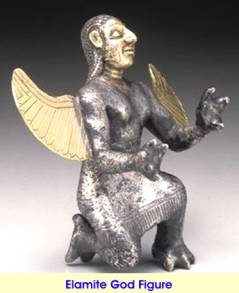Little is known of the cultures of Iran during the early Bronze ages. However, it is clear that during these early periods, the rugged broken landscape of the Iranian Plateau, forced man into a variety of relatively isolated cultures. These cultures did not participate in the developments, that led to the fully urban civilizations in Egypt and Mesopotamia to their west, or in the Indus Valley to their south.
 |  |  |
Except for Elam, which was contemporary with its neighboring cultures in every way. Here they had the same high level of civilization as their neighbors, with the same agriculture, the same architecture (the Elamites built Ziggurats too), and the same technology in mathematics and the sciences. The center of Elam was (what is now) "Khuzestan". Though geographically, Elam included more than Khuzestan, it was a combination of the lowlands, and the immediate highland areas to the north and east. The major cities of Elam were, Awan, Anshan, Simash, and Susa. Susa later became Elam's capital.
 |
Elam's strength was based on it's ability to hold these various areas together, under a coordinated government that permitted the maximum interchange of natural resources that were unique to each region. (Elam was, as Afghanistan is today, the worlds major source of lapis Lazuli, which was greatly prized). Traditionally this was done through a federated government structure. Closely related to this form of government, was the Elamite system of inheritance and power distribution. The normal pattern of government for Elam was that of a king or overlord, ruling over vassal princes.
In the earliest times, the king was required to live in Susa, which functioned as the federal capital. With him ruled his brother closest in age (the viceroy), who usually had his seat of government in the native city of the currently ruling king. This viceroy was heir presumptive to the king. Yet a third official, the regent or prince of Susa (the district), shared power with the king and the viceroy. He was usually the kings son, or if no son was available, his nephew. On the death of the king, the viceroy became king. The prince of Susa remained in office, and the brother of the old viceroy nearest to him in age became the new viceroy. Only if all brothers were dead, was the prince of Susa promoted to viceroy, thus enabling the king to name his own son (or nephew), as the new prince of Susa.
Such a complicated system of governmental checks, balances, and power inheritance, often broke down, despite bilateral descent and levirate marriage, ( the compulsory marriage of a widow to her deceased husband's brother). What is remarkable is how often the system did work; it was only in the Middle and Neo-Elamite periods that sons more often succeeded fathers to power. The Elamite people were closely tied, culturally and otherwise, to Mesopotamia. Later, perhaps because of domination by the Akkadian dynasty (2334-2154 BC), Elamites adopted the Sumerian-Akkadian system of writing (the cuneiform script).
  |  |  |
Little is known of the Elamite pantheon, except to say that the Elamites, in their many excursions into Sumer, were very fond of carrying off huge Sumerian statues of their gods, and installing them in Susa.
Consequently, perhaps the best way to think of the Elamites and their cities, is simply as an extension of Sumer and its cities. The two countries were culturally pretty much the same, and the people were ethnically the same - as attested to by later Assyrian relief's of the two peoples, in appearance and dress, they are indistinguishable one from the other.
 |
Politically, Elam was closely involved with Sumer, Akkad, and Assyria, sometimes through peaceful trade, more often through war. In like manner, Elam was often a participant in the events of the Iranian Plateau. These involvements were related to the combined need of all the lowland civilizations to control the warlike peoples to the east, and to exploit the economic resources of the plateau.
The earliest kings in the Old Elamite period, may date to approximately 3,000 B.C. Already conflict with Sumer, especially with the city of Ur, was characteristic of Elamite history. In one case, according to the Sumerian King list, “Sumerian king Enmenbaragesi, made Elam submit”. The early Susa rulers were succeeded by the Awan (Shustar) dynasty. An early king of this dynasty, returned the favor to Sumer, he attacked and defeated Ur, and Elam ruled Sumer for the next 350 years.
 |  |  |
Elamite rule was broken when King Susuda of Kish defeated the Elamites. There soon appeared a new ruling house in Elam, the Simash dynasty, (Simash may have been in the mountains of southern Luristan). The most notable event of this period, was the virtual conquest of Elam by King Shulgi of the 3rd dynasty of Ur (2094–2047 BC). Eventually the Elamites rose in rebellion, and overthrew the 3rd Ur dynasty, an event long remembered in Mesopotamian dirges and omen texts.
At about 1900 B.C, power in Elam passed to a new dynasty, that of Eparti. The third king of this line "Shirukdukh" was active in various military coalitions against the rising power of Babylon, but Hammurabi (1792–1750 B.C.) was not to be denied, and Elam was crushed in 1764 B.C. The Old Babylon kingdom however, fell into rapid decline following the death of Hammurabi, and it was not long before the Elamites were able to gain revenge.
Elamite king "Kutir-Nahhunte I" attacked Samsuiluna (1749–1712 B.C.) Hammurabi's son, and dealt so serious a defeat to the Babylonians that the event was remembered more than 1,000 years later in an inscription of the Assyrian king Ashurbanipal. It may be assumed that with this stroke Elam once again gained independence. The end of the Eparti dynasty, which may have come in the late 16th century B.C, is buried in silence.
No comments:
Post a Comment